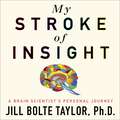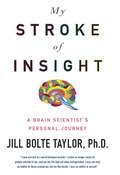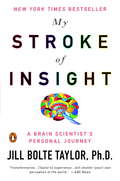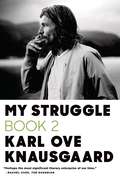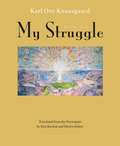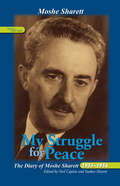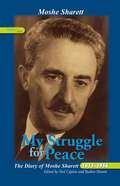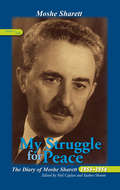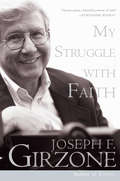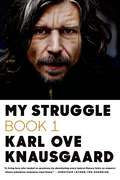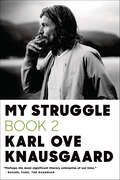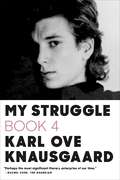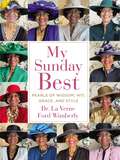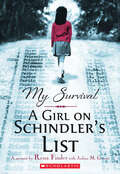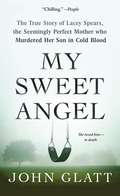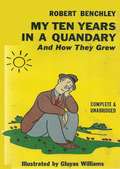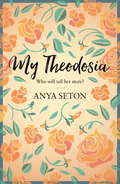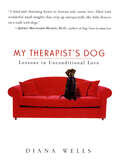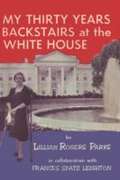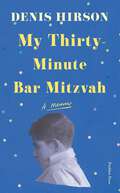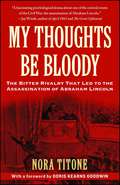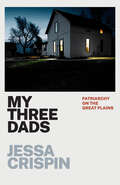- Table View
- List View
My Stroke of Insight
by Jill Bolte TaylorThe international bestseller and recommended by medics, patients and the NHS, this is a brain scientist's personal experience of a stroke. It tells of her journey and gives rare insight into human consciousness and its possibilities for all of us.On the morning of the 10th December 1996, Jill Bolte Taylor, a thirty-seven-year-old Harvard-trained brain scientist experienced a massive stroke when a blood vessel exploded in the left side of her brain. A neuroanatomist by profession, she observed her own mind completely deteriorate to the point that she lost the ability to walk, talk, read, write, or recall any of her life, all within the space of four hours. As the damaged left side of her brain - the rational, logical, detail and time-oriented side - swung in an out of function, Taylor alternated between two distinct and opposite realities: the euphoric Nirvana of the intuitive and emotional right brain, in which she felt a sense of complete well-being and peace; and the logical left brain, that realized Jill was having a stroke and enabled her to seek help before she was lost completely. In My Stroke of Insight: A Brain Scientist's Personal Journey, Taylor brings to light a new perspective on the brain and its capacity for recovery that she gained through the intimate experience of awakening her own injured mind. The journey to recovery took eight years for Jill to feel completely healed. Using her knowledge of how the brain works, her respect for the cells composing her human form, and an amazing mother, Taylor completely repaired her mind and recalibrated her understanding of the world according to the insight gained from her right brain that December morning.(P)2008 Penguin Audiobooks
My Stroke of Insight: A Brain Scientist's Personal Journey
by Jill Bolte TaylorA 37-year-old brain scientist has a massive stroke and observes her own mind deteriorate to the point where she can't walk, talk, read, write or recall her life, within 4 hours.
My Stroke of Insight: A Brain Scientist's Personal Journey
by Jill Bolte TaylorThe astonishing New York Times bestseller that chronicles how a brain scientist's own stroke led to enlightenment On December 10, 1996, Jill Bolte Taylor, a thirty-seven- year-old Harvard-trained brain scientist experienced a massive stroke in the left hemisphere of her brain. As she observed her mind deteriorate to the point that she could not walk, talk, read, write, or recall any of her life-all within four hours-Taylor alternated between the euphoria of the intuitive and kinesthetic right brain, in which she felt a sense of complete well-being and peace, and the logical, sequential left brain, which recognized she was having a stroke and enabled her to seek help before she was completely lost. It would take her eight years to fully recover. For Taylor, her stroke was a blessing and a revelation. It taught her that by "stepping to the right" of our left brains, we can uncover feelings of well-being that are often sidelined by "brain chatter." Reaching wide audiences through her talk at the Technology, Entertainment, Design (TED) conference and her appearance on Oprah's online Soul Series, Taylor provides a valuable recovery guide for those touched by brain injury and an inspiring testimony that inner peace is accessible to anyone.
My Struggle (Book Two): A Man In Love
by Don Bartlett Karl Ove KnausgaardIn the second installment of Karl Ove Knausgaard's monumental six-volume masterpiece, the character Karl Ove Knausgaard moves to Stockholm, where, having left his wife, he leads a solitary existence. He strikes up a deep friendship with another exiled Norwegian, a Nietzschean intellectual and boxing fanatic named Geir. He also tracks down Linda, whom he met at a writers' workshop a few years earlier and who fascinated him deeply. My Struggle: Book 2 is at heart a love story—the story of Karl Ove falling in love with his second wife. But the novel also tells other stories: of becoming a father, of the turbulence of family life, of outrageously unsuccessful attempts at a family vacation, of the emotional strain of birthday parties for children, and of the daily frustrations, rhythms, and distractions of city life keeping him from (and filling) his novel. It is a brilliant work that emphatically delivers on the unlikely promise that many hundreds of pages later readers will be left breathlessly demanding more.
My Struggle (My Struggle Series #6)
by Karl Ove KnausgaardThis book is the final installment of My Struggle series. Grappling directly with the consequences of Knausgaard's transgressive blurring of public and private Book Six is a troubling and engrossing look into the mind of one of the most exciting artists of our time.
My Struggle for Peace, Volume 1: The Diary of Moshe Sharett, 1953–1956 (The Diary of Moshe Sharett, 1953–1956 #1)
by Moshe SharettThe first volume of the former Israeli prime minister’s journals from the nation’s early years.My Struggle for Peace is a remarkable political document offering insights into the complex workings of the young Israeli political system, set against the backdrop of the disintegration of the country’s fragile armistice with the Arab states. Replete with Moshe Sharett’s candid comments on Israel’s first-generation leaders and world statesmen of the day, the diary also tells the dramatic human story of a political career cut short—the removal of an unusually sensitive, dedicated, and talented public servant. My Struggle for Peace is, above all, an intimate record of the decline of Sharett’s moderate approach and the rise of more “activist-militant” trends in Israeli society, culminating in the Suez/Sinai war of 1956. The diary challenges the popular narrative that Israel’s confrontation with its neighbors was unavoidable by offering daily evidence of Sharett’s statesmanship, moderation, diplomacy, and concern for Israel’s place in international affairs.This is the first volume in the 3-volume English abridgement of Sharett’s Yoman Ishi [Personal diary] (Ma’ariv, 1978) maintains the integrity, flavor, and impact of the 8-volume Hebrew original and includes additional documentary material that was not accessible at the time. The volumes are also available to purchase as a set or individually.“The editors . . . vastly improved on the Hebrew version by adding Sharett’s speeches, reports, cabinet minutes, and other sources to the text’. . . . These additions makes this work so important and welcome by all who aspire to understand the foreign and defense policies of Israel in its first decade.” —Israel Studies Review
My Struggle for Peace, Volume 2: The Diary of Moshe Sharett, 1953–1956 (The Diary of Moshe Sharett, 1953–1956 #2)
by Moshe SharettThe second volume of the former Israeli prime minister&’s journals from the nation&’s early years, centering on his time in office.My Struggle for Peace is a remarkable political document offering insights into the complex workings of the young Israeli political system, set against the backdrop of the disintegration of the country&’s fragile armistice with the Arab states. Replete with Moshe Sharett&’s candid comments on Israel&’s first-generation leaders and world statesmen of the day, the diary also tells the dramatic human story of a political career cut short—the removal of an unusually sensitive, dedicated, and talented public servant. My Struggle for Peace is, above all, an intimate record of the decline of Sharett&’s moderate approach and the rise of more &“activist-militant&” trends in Israeli society, culminating in the Suez/Sinai war of 1956. The diary challenges the popular narrative that Israel&’s confrontation with its neighbors was unavoidable by offering daily evidence of Sharett&’s statesmanship, moderation, diplomacy, and concern for Israel&’s place in international affairs. This is the second volume in the 3-volume English abridgement of Sharett&’s Yoman Ishi [Personal diary] (Ma&’ariv, 1978) maintains the integrity, flavor, and impact of the 8-volume Hebrew original and includes additional documentary material that was not accessible at the time. The volumes are also available to purchase as a set or individually.&“The editors . . . vastly improved on the Hebrew version by adding Sharett&’s speeches, reports, cabinet minutes, and other sources to the text. . . . These additions makes this work so important and welcome by all who aspire to understand the foreign and defense policies of Israel in its first decade.&” —Israel Studies Review
My Struggle for Peace, Volume 3: The Diary of Moshe Sharett, 1953–1956 (The Diary of Moshe Sharett, 1953–1956 #3)
by Moshe SharettThe third volume of the former Israeli prime minister&’s journals from the nation&’s early years.My Struggle for Peace is a remarkable political document offering insights into the complex workings of the young Israeli political system, set against the backdrop of the disintegration of the country&’s fragile armistice with the Arab states. Replete with Moshe Sharett&’s candid comments on Israel&’s first-generation leaders and world statesmen of the day, the diary also tells the dramatic human story of a political career cut short—the removal of an unusually sensitive, dedicated, and talented public servant. My Struggle for Peace is, above all, an intimate record of the decline of Sharett&’s moderate approach and the rise of more &“activist-militant&” trends in Israeli society, culminating in the Suez/Sinai war of 1956. The diary challenges the popular narrative that Israel&’s confrontation with its neighbors was unavoidable by offering daily evidence of Sharett&’s statesmanship, moderation, diplomacy, and concern for Israel&’s place in international affairs. This is the third volume in the 3-volume English abridgement of Sharett&’s Yoman Ishi [Personal diary] (Ma&’ariv, 1978) maintains the integrity, flavor, and impact of the 8-volume Hebrew original and includes additional documentary material that was not accessible at the time. The volumes are also available to purchase as a set or individually.&“The editors . . . vastly improved on the Hebrew version by adding Sharett&’s speeches, reports, cabinet minutes, and other sources to the text. . . . These additions makes this work so important and welcome by all who aspire to understand the foreign and defense policies of Israel in its first decade.&” —Israel Studies Review
My Struggle for Peace, Volume 3: The Diary of Moshe Sharett, 1953–1956 (The Diary of Moshe Sharett, 1953–1956)
by Moshe SharettThe third volume of the former Israeli prime minister&’s journals from the nation&’s early years.My Struggle for Peace is a remarkable political document offering insights into the complex workings of the young Israeli political system, set against the backdrop of the disintegration of the country&’s fragile armistice with the Arab states. Replete with Moshe Sharett&’s candid comments on Israel&’s first-generation leaders and world statesmen of the day, the diary also tells the dramatic human story of a political career cut short—the removal of an unusually sensitive, dedicated, and talented public servant. My Struggle for Peace is, above all, an intimate record of the decline of Sharett&’s moderate approach and the rise of more &“activist-militant&” trends in Israeli society, culminating in the Suez/Sinai war of 1956. The diary challenges the popular narrative that Israel&’s confrontation with its neighbors was unavoidable by offering daily evidence of Sharett&’s statesmanship, moderation, diplomacy, and concern for Israel&’s place in international affairs. This is the third volume in the 3-volume English abridgement of Sharett&’s Yoman Ishi [Personal diary] (Ma&’ariv, 1978) maintains the integrity, flavor, and impact of the 8-volume Hebrew original and includes additional documentary material that was not accessible at the time. The volumes are also available to purchase as a set or individually.&“The editors . . . vastly improved on the Hebrew version by adding Sharett&’s speeches, reports, cabinet minutes, and other sources to the text. . . . These additions makes this work so important and welcome by all who aspire to understand the foreign and defense policies of Israel in its first decade.&” —Israel Studies Review
My Struggle with Faith
by Joseph F. GirzoneThe author of the bestselling Joshua series and other popular inspirational books chronicles his own spiritual journey and describes with stunning honesty the difficult decisions he made along the way. Joseph Girzone has attracted a tremendous following with his series of novels that imagine Jesus living in the contemporary world. His nonfiction writings and talks on spirituality have affected audiences around the world. Girzone’s ability to capture the meaning of faith in simple, direct language is more apparent than ever in this moving book about his personal journey through a dark night of the soul. InMy Struggle with Faith, Girzone recounts the long, complicated, and often painful process he went though as he sought to find peace with his beliefs. He writes about hard decisions that set him on unexpected paths and about the immense feelings of loneliness he experienced in making those choices. In thoughtful and thought-provoking reflections he brings to life the years of searching and the deep, critical thinking that gave him the courage to embrace his beliefs, opening a world of excitement and adventure for him. In writing about what his beliefs have meant to him and about the intimate relationship with God that has sustained and guided him, Girzone illuminates the universal human struggle to find meaning in life. My Struggle with Faithoffers readers insights, inspiration, and encouragement to follow their beliefs and create a more meaningful spiritual life.
My Struggle, Book 1
by Don Bartlett Karl Ove KnausgaardThis first book of My Struggle introduces American readers to the audacious, addictive, and profoundly surprising international literary sensation that is the provocative six-volume autobiographical novel by Karl Ove Knausgaard. Unafraid of the big issues death, love, art, fear and yet committed to the intimate details of life as it is lived, "My Struggle "is an essential work of contemporary literature.
My Struggle: A Man In Love (My Struggle #2)
by Karl Ove KnausgaardThe second book in “perhaps the most significant literary enterprise of our time” from the international bestselling author of The Third Realm (Rachel Cusk, The Guardian).Finalist—The Independent Foreign Fiction PrizeA Wall Street Journal Best Book of the YearIn the second installment of Karl Ove Knausgaard’s monumental six-volume masterpiece, the character Karl Ove Knausgaard moves to Stockholm, where, having left his wife, he leads a solitary existence. He strikes up a deep friendship with another exiled Norwegian, a Nietzschean intellectual and boxing fanatic named Geir. He also tracks down Linda, whom he met at a writers’ workshop a few years earlier and who fascinated him deeply.My Struggle: Book 2 is at heart a love story—the story of Karl Ove falling in love with his second wife. But the novel also tells other stories: of becoming a father, of the turbulence of family life, of outrageously unsuccessful attempts at a family vacation, of the emotional strain of birthday parties for children, and of the daily frustrations, rhythms, and distractions of city life keeping him from (and filling) his novel.It is a brilliant work that emphatically delivers on the unlikely promise that many hundreds of pages later readers will be left breathlessly demanding more.“Achieves an aching intimacy, one that transcends the personal and makes Knausgaard’s pursuit of grand artistic ideals, his daily joys and misgivings, strangely familiar.” —Time Out New York“Knausgaard has written one of those books so aesthetically forceful as to be revolutionary.” —The Paris Review
My Struggle: Book 4 (My Struggle #4)
by Don Bartlett Karl Ove KnausgaardMy Struggle: Book 4 finds an eighteen-year-old Karl Ove Knausgaard in a tiny fishing village in northern Norway, where he has been hired as a schoolteacher and is living on his own for the first time. When the ferocious winter takes hold, Karl Ove--in the company of the Håfjord locals, a warm and earthy group who have spent their lives working, drinking, and joking together in close quarters--confronts private demons, reels from humiliations, and is elated by small victories. We are immersed, along with Karl Ove, in this world--sometimes claustrophobic, sometimes serenely beautiful--where memories and physical obsessions burn throughout the endless Arctic winter. In Book 4, Karl Ove must weigh the realities of his new life as a writer against everything he had believed it would be.
My Sunday Best: Pearls of Wisdom, Wit, Grace, and Style
by La Verne WimberlyAfter posting selfies in her Sunday best for fifty-two consecutive weeks during the pandemic, octogenarian Dr. La Verne Ford Wimberly became a viral sensation during Easter 2021, appearing everywhere from the Washington Post to CNN to Fox News."People from all over the world have said my Sunday selfies and words of encouragement have blessed and inspired them. Who would have thought photos of an eighty-two-year-old church lady in a hat and Bible verses could do such a thing?"On March 29, 2020, when her church switched to online services because of coronavirus, Dr. La Verne Ford Wimberly couldn't imagine watching the service in her robe. So, she did what she's always done; she put on a beautiful outfit, matching hat, and accessories and got ready for church. Dr. Wimberly, a self-declared social media junkie, thought "it would be fun to snap a selfie and post it on Facebook with a scripture verse and an inspirational message. I'd let folks know I was ready for worship and encourage them to do the same. This was my way to brighten their spirits--and mine--and stay connected during a time of sudden isolation and despair for many people."Underneath her "crown" and church finery is a wise, warm, and witty octogenarian who's still committed to the same values she learned in childhood:faith in God and country,devotion to family,keeping a positive attitude,a life of service,thinking before you act,living life to the fullest, andthe golden rule. As a career educator who faithfully and lovingly served students, their families, and her community for decades, encouraging and uplifting others is part of Dr. Wimberly's DNA. In My Sunday Best, you'll be cheered by the stories and lessons from a life well-lived and find yourself asking, How can I inspire someone today and encourage myself too?
My Survival: A Girl On Schindler's List
by Joshua M. Greene Rena FinderThe astonishing true story of a girl who survived the Holocaust thanks to Oskar Schindler, of Schindler's List fame.Rena Finder was only eleven when the Nazis forced her and her family -- along with all the other Jewish families -- into the ghetto in Krakow, Poland. Rena worked as a slave laborer with scarcely any food and watched as friends and family were sent away.Then Rena and her mother ended up working for Oskar Schindler, a German businessman who employed Jewish prisoners in his factory and kept them fed and healthy. But Rena's nightmares were not over. She and her mother were deported to the concentration camp Auschwitz. With great cunning, it was Schindler who set out to help them escape.Here in her own words is Rena's gripping story of survival, perseverance, tragedy, and hope. Including pictures from Rena's personal collection and from the time period, this unforgettable memoir introduces young readers to an astounding and necessary piece of history.
My Sweet Angel
by John GlattTo the outside world Lacey had seemed like a loving, concerned mother, regularly posting updates on social media about her son's harrowing medical problems. But in reality, Lacey was a textbook case of Munchausen syndrome by proxy.
My Ten Years as a Counterspy
by Boris Morros Charles SamuelsBoris Morros was a successful Hollywood producer and a highly regarded musician and impresario. His life had been a legendary success story even in the flamboyant annals of show business. What chain of events in 1936 led him into serving the interests of a Soviet spy ring? What even more dramatic events brought him into the office of the FBI in 1947 to take on the role of a United States counterspy? How did Morros manage to deceive Communist agents and help provide the evidence which resulted, in the exposure and conviction of the, leaders of the spy ring? This book, for the first time, unfolds the entire drama of the ten-year ordeal of Boris Morros.
My Ten Years in a Quandary and How They Grew
by Robert BenchleyWhen Robert Benchley died in 1945, his obituaries read like love-letters from the world. Here is a collection of his short, whimsical, hilarious articles which show why.With befuddled and heroic bewilderment Benchley faces his problems. Among others are the mislaid locomotive, a dachshund who sued for libel, and a songbird who was "out to get" Benchley.It ends with five sizzling chapters of his "Untold Story," starting when, as an innocent young man from the country (Boston), he arrived in the city (New York) looking for pitfalls. (It was a holiday and they were all closed.)"...it is a saga of the gaga, and probably not far from his masterpiece."--New York TimesA rare gem of a book!Illustrated by Gluyas Williams
My Theodosia
by Anya SetonA compelling romance and portrayal of a fascinating figure in American history, from the bestselling author of Katherine.Theodosia is the daughter of Aaron Burr, Vice President of the United States serving under Thomas Jefferson. She is unwaveringly devoted to her father and he worships her. But his arrogant ambitions force her to choose between the man he insists she marry and the young soldier she truly loves. These same ambitions set in motion a chain of events that will end in treason and tragedy. Based on meticulous research, Anya Seton's first novel, originally published in 1941, captures all the drama of the short life of Theodosia Burr (1783-1813).
My Therapist's Dog: Lessons in Unconditional Love
by Diana WellsDiana Wells's intriguing exploration into the rewards of relationships--both the canine and human varieties--begins when she reluctantly starts seeing a psychologist, Beth, during a difficult time in her life. With no insurance to pay for counseling, a barter is arranged in which the client becomes part-time caretaker to the therapist's dog, Luggs, a sweet, clumsy black Labrador retriever. As Wells examines her past--her peripatetic childhood, her eccentric family, her grief over the deaths of loved ones--Luggs provides a bridge between therapist and patient. Dog lover by nature, historian by trade, Wells finds herself curious about the connections that dogs and humans have shared for centuries--and what these bonds tell us about our own psyches. Wells observes that training a dog has much in common with the therapeutic techniques her psychologist employs. Looking into recent experiments that have proved dogs better at interpreting human behavior than chimps or wolves, Wells explores the subtleties of her own relationship with dogs. Increasingly she finds herself agreeing with Diogenes, the original Greek cynic (the word cynic comes from the greek kuon, meaning "dog"), who said that unless we think like dogs, happiness will elude us. Wells analyzes what we name our dogs, how we breed them, how we've explored the wilderness with them, the kinds of literature we write about them, why we love them, and, most important, what we can learn from them. When an unexpected illness befalls Beth, Luggs comforts the two women, and his devotion helps Wells come to accept that relationships--despite the possibility of hurt and pain--are what life is all about.
My Thirty Years Backstairs at the White House
by Lillian Rogers Parks Frances Spatz LeightonThis book should be required reading for every serious student of American history. The authors were eye witnesses to some of the great events of history and offer different perspectives from that found elsewhere. The unique perspective offered by this book arises from the fact that the authors are two White House domestic servants, each of whom worked for 30 years in the White House. As there was an overlap of ten years that both of them worked there together, that means that they were in the White House for a 51-year span from the end of 1909 until 1960, when Lillian Rogers Parks retired at age 64 in the concluding days of the Eisenhower Administration.
My Thirty-Minute Bar Mitzvah: A Memoir
by DENIS HIRSONA &“beautifully written, funny and deeply moving&” memoir about a son&’s reckoning with his father&’s political idealism, set against the menacing backdrop of apartheid-era South Africa (Finuala Dowling, author of The Man Who Loved Crocodile Tamers)A bestselling South African writer known for tackling history and memory finally makes his American debutWitty and deeply poignant, My Thirty-Minute Bar Mitzvah is a breathtaking account of one man being confronted by his past and, ultimately, how his daughter proved to be the key in understanding his own father.Recreating 1960s Johannesburg through his adolescent eyes, bestselling South African author Denis Hirson gradually reveals the details of his extraordinary 13th birthday as he explores the familial and political divisions in Apartheid South Africa that weighed on him and his developing consciousness of his Jewish heritage.My Thirty-Minute Bar Mitzvah is a gem of a book about becoming a man. It&’s also a valuable account of a forgotten time of white, Jewish activists, their families, their community, and most importantly, their children, who had to stumble through life in the aftermath of their commitment to racial justice.
My Thoughts Be Bloody
by Nora TitoneThe scene of John Wilkes Booth shooting Abraham Lincoln in Ford's Theatre is among the most vivid and indelible images in American history. The literal story of what happened on April 14, 1865, is familiar: Lincoln was killed by John Wilkes Booth, a lunatic enraged by the Union victory and the prospect of black citizenship. Yet who Booth really was--besides a killer--is less well known. The magnitude of his crime has obscured for generations a startling personal story that was integral to his motivation. My Thoughts Be Bloody, a sweeping family saga, revives an extraordinary figure whose name has been missing, until now, from the story of President Lincoln's death. Edwin Booth, John Wilkes's older brother by four years, was in his day the biggest star of the American stage. He won his celebrity at the precocious age of nineteen, before the Civil War began, when John Wilkes was a schoolboy. Without an account of Edwin Booth, author Nora Titone argues, the real story of Lincoln's assassin has never been told. Using an array of private letters, diaries, and reminiscences of the Booth family, Titone has uncovered a hidden history that reveals the reasons why John Wilkes Booth became this country's most notorious assassin. These ambitious brothers, born to theatrical parents, enacted a tale of mutual jealousy and resentment worthy of a Shakespearean tragedy. From childhood, the stage-struck brothers were rivals for the approval of their father, legendary British actor Junius Brutus Booth. After his death, Edwin and John Wilkes were locked in a fierce contest to claim his legacy of fame. This strange family history and powerful sibling rivalry were the crucibles of John Wilkes's character, exacerbating his political passions and driving him into a life of conspiracy. To re-create the lost world of Edwin and John Wilkes Booth, this book takes readers on a panoramic tour of nineteenth-century America, from the streets of 1840s Baltimore to the gold fields of California, from the jungles of the Isthmus of Panama to the glittering mansions of Gilded Age New York. Edwin, ruthlessly competitive and gifted, did everything he could to lock his younger brother out of the theatrical game. As he came of age, John Wilkes found his plans for stardom thwarted by his older sibling's meteoric rise. Their divergent paths--Edwin's an upward race to riches and social prominence, and John's a downward spiral into failure and obscurity--kept pace with the hardening of their opposite political views and their mutual dislike. The details of the conspiracy to kill Lincoln have been well documented elsewhere. My Thoughts Be Bloody tells a new story, one that explains for the first time why Lincoln's assassin decided to conspire against the president in the first place, and sets that decision in the context of a bitterly divided family--and nation. By the end of this riveting journey, readers will see Abraham Lincoln's death less as the result of the war between the North and South and more as the climax of a dark struggle between two brothers who never wore the uniform of soldiers, except on stage.
My Three Dads: Patriarchy on the Great Plains
by Jessa CrispinSharp and thought-provoking, this memoir-meets-cultural criticism upends the romanticism of the Great Plains and the patriarchy at the core of its ideals. For many Americans, Kansas represents a vision of Midwestern life that is good and wholesome and evokes the American ideals of god, home, and country. But for those like Jessa Crispin who have grown up in Kansas, the realities are much harsher. She argues that the Midwestern values we cling to cover up a long history of oppression and control over Native Americans, women, and the economically disadvantaged. Blending personal narrative with social commentary, Crispin meditates on why the American Midwest still enjoys an esteemed position in our country's mythic self-image. Ranging from The Wizard of Oz to race, from chastity to rape, from radical militias and recent terrorist plots to Utopian communities, My Three Dads opens on a comic scene in a Kansas rent house the author shares with a (masculine) ghost. This prompts Crispin to think about her intellectual fathers, her spiritual fathers, and her literal fathers. She is curious to understand what she has learned from them and what she needs to unlearn about how a person should be in a family, as a citizen, and as a child of god—ideals, Crispin argues, that have been established and reproduced in service to hierarchy, oppression, and wealth. Written in Crispin’s well-honed voice—smart, assured, comfortable with darkness—My Three Dads offers a kind of bleak redemption, the insight that no matter where you go, no matter how far from home you roam, the place you came from is always with you, “like it or not.”
